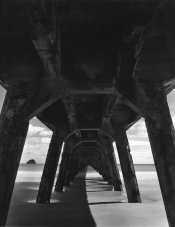VinceInMT
Subscriber
There are some good suggestion to the original query. I use, I think, a 0000 brush and Spotone and Marshall dyes. I have a piece of glass on which I have put drops of the various colors and let them dry out. I mix them on that glass if needed. I use a small cup of water and the backside of an old print for testing. Rotate the brush to keep the point. When applying the dye I think of it as rebuilding the missing grain structure, that is, I am creating a texture, not just filling a space.
Back in the 70s I worked a graveyard shift in a medium sized film processing plant and when I would be waiting around for something I worked with our spotter and eventually got pretty good at it, if fact, I really like it. It’s meditative.
It’s no surprise that in my other art practice, drawing, stippling is my favorite technique.
Back in the 70s I worked a graveyard shift in a medium sized film processing plant and when I would be waiting around for something I worked with our spotter and eventually got pretty good at it, if fact, I really like it. It’s meditative.
It’s no surprise that in my other art practice, drawing, stippling is my favorite technique.












